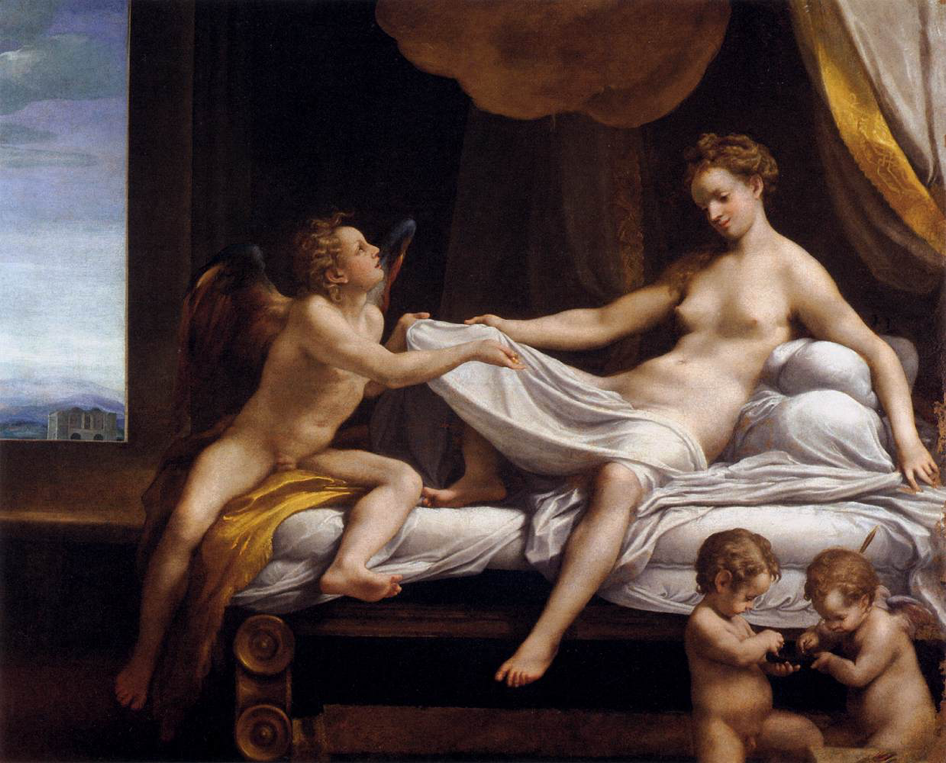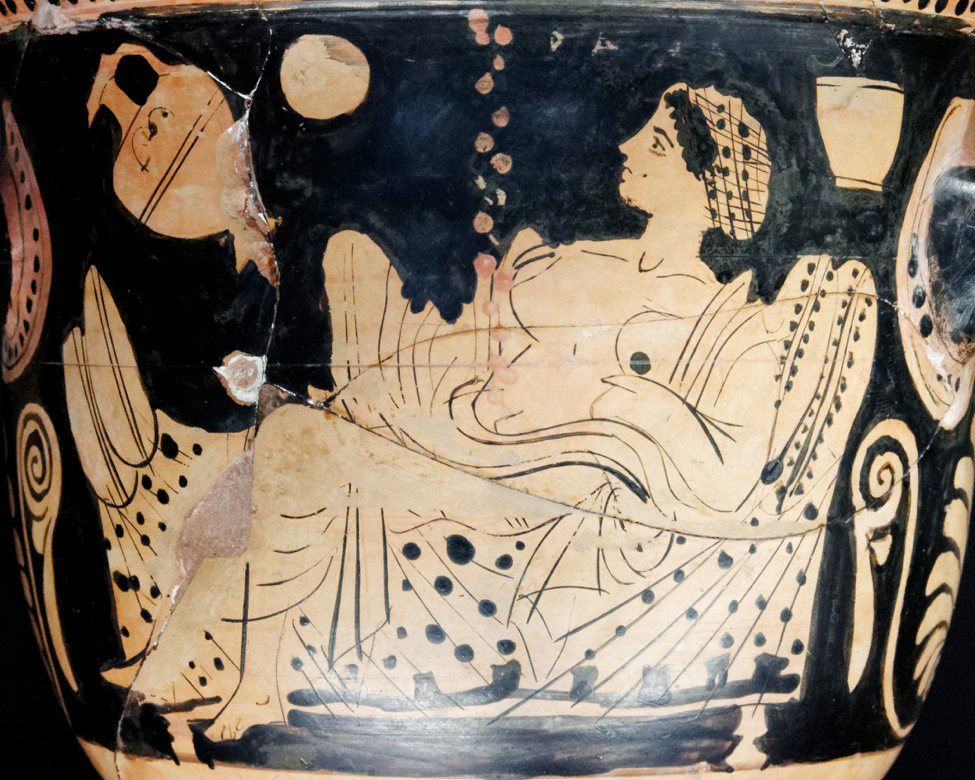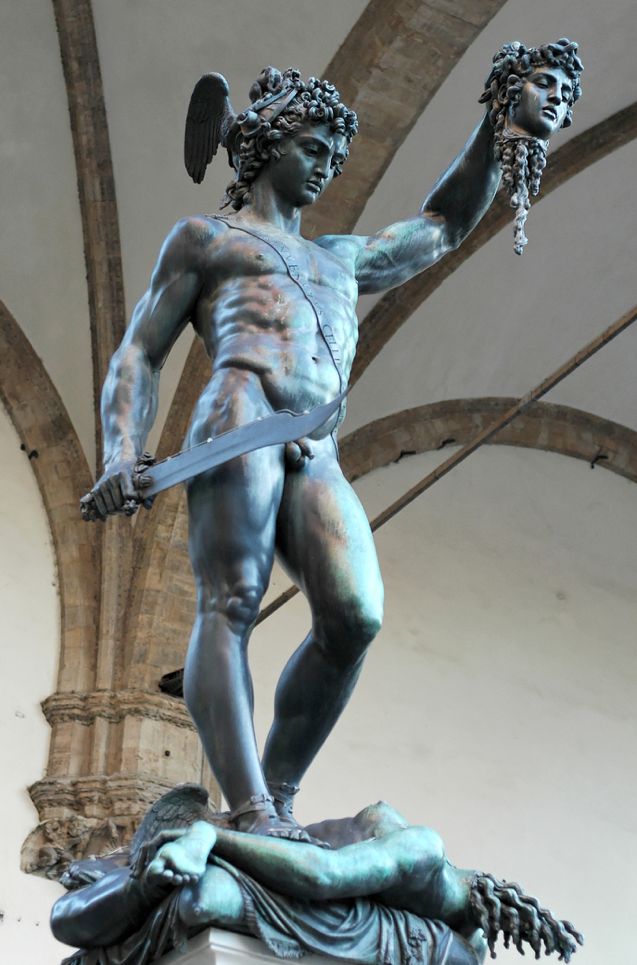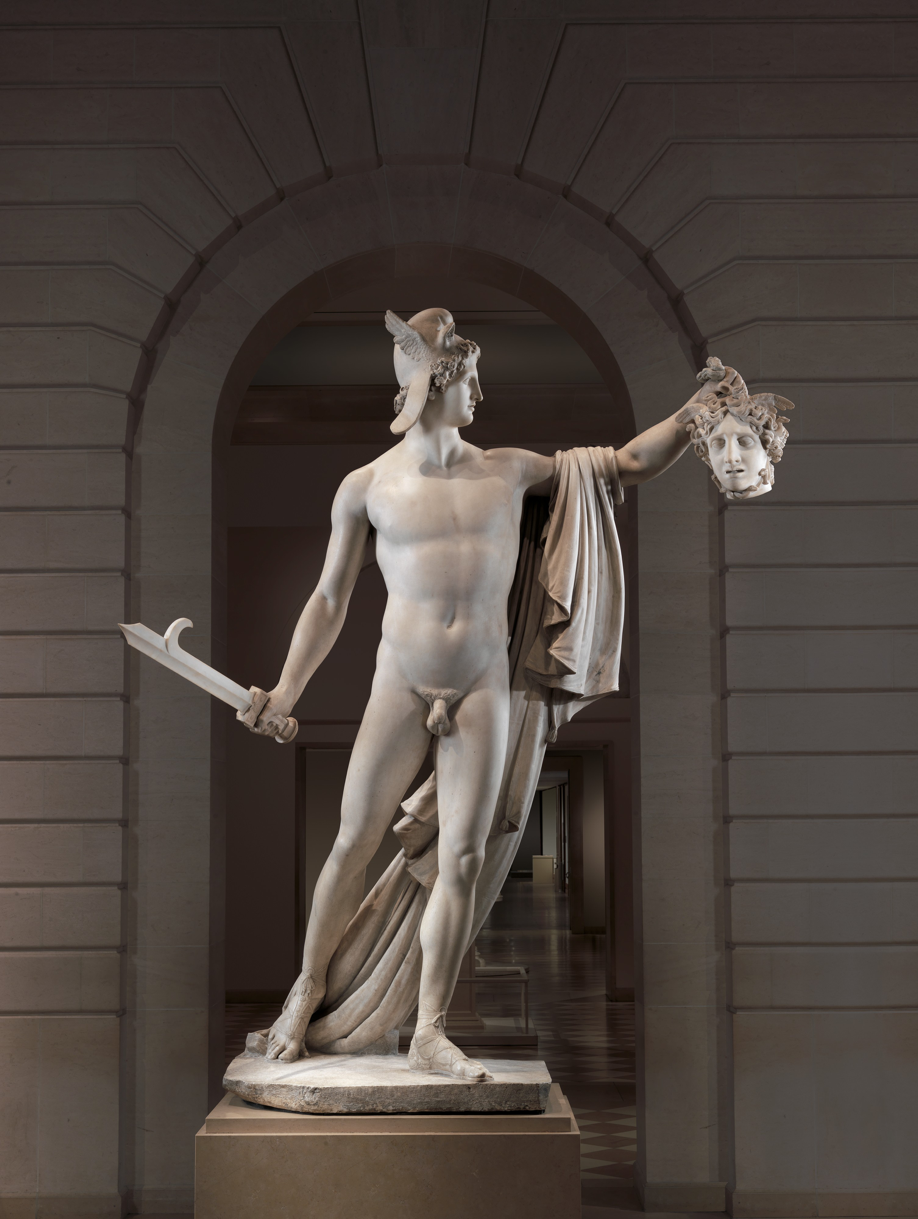Perseus is the only Greek hero (that I am aware of) who does NOT fit the Story Pattern of the Greek Hero (see the Story Pattern of the Greek Hero). To be sure, Perseus does fit parts of the pattern: he certainly has an unusual birth, and he does go on a Heroic Journey in which he accomplishes Heroic Tests. But Perseus does not accomplish any Early Tests (that I know of), and, most importantly, Perseus is the only one of all the Greek heroes who has a happy life after he has accomplished his heroic journey and who does NOT have an unhappy death. I guess you could say that Perseus is the exception that proves the rule.
I. Unusual Birth:
Acrisius, the king of Argos [see map], had a daughter, but no sons, so he consulted the Delphic Oracle to see how he could get an heir to the throne. But the oracle he received made him forget the reason why he had consulted the Oracle in the first place. The Delphic Oracle said: “Your daughter’s son will kill you.”

Danaë by Correggio (1530) in the Galleria Borghese in Rome
Of course, Acrisius wanted to do everything he could to prevent this. So he put his daughter, Danaë, in a bronze prison, and he would not let any man near her. But Zeus fell in love with her, and he visited her in the form of a shower of golden rain. Nine months later, Danaë gave birth to Perseus.

Danaë and Zeus disguised as a shower of gold on a krater in the Louvre
Acrisius put them both in a wooden chest and put them out to sea. But the chest floated safely to the island of Seriphos, where it was found by Dictys, the brother of the king. Dictys took both mother and child into his home, and treated them like members of his family. Perseus received a good upbringing in Dictys’ care.
All went well for many years, until Polydectes, Dictys’ brother and the king of Seriphos, fell in love with Danaë and wanted to marry her. Danaë refused, and Perseus, who was now a young man, defended his mother, so Polydectes decided to find a way to get rid of Perseus.
II. Early Tests:
Apparently none.
III. & IV. Heroic Journey & Tests:
1. Polydectes told everyone that he was planning to marry Hippodameia, the daughter of the wealthy King Oinomaos of Pisa, and he asked all the men in his kingdom to contribute something toward the substantial bride price that he would have to pay. When asked for a contribution, Perseus said (a bit dramatically) that he would begrudge Polydectes nothing, and that he would even give him the Gorgon’s head. But Polydectes held the youth to his promise. So Perseus set out to retrieve the head of the Gorgon, Medusa. Of course, Polydectes had no intention of marrying Hippodameia, and he was well aware of the problematic nature of Perseus’ quest.
There were actually three Gorgon sisters, but the other two Gorgons were immortal. Since Medusa was the only Gorgon who was capable of being killed, it was her head that Perseus was going to seek. But there was one, huge problem: anyone who looked at Medusa would instantly be turned into stone. So how could anyone kill her without dying before he could complete the mission? Fortunately for Perseus, however, Athena already hated Medusa (for the reason why, see Poseidon), so Athena decided to help Perseus kill her.

Perseus killing Medusa and Pegasus being born from her head on a lekythos in the Metropolitan Museum of Art in New York City
First, Athena helped Perseus find the Graeae. The Graeae were three old sisters, who shared a single eye between them. The Graeae did not want to help Perseus, but he managed to steal their eye as they were passing it from one to another; Perseus refused to give back the eye until they helped him, so they agreed. The Graeae told Perseus about some nymphs and where to find them. And when Perseus found the nymphs, they gave him three important gifts: winged sandals, which would allow him to fly through the air; a cap of darkness, which would make him invisible; and a special metallic pouch for Medusa’s head.

Perseus by Cellini (1554) found under the Loggia dei Lanzi in Florence
Athena also told Perseus not to look at Medusa directly while killing her with his sword, but to look at Medusa’s reflection in his shield, to avoid being turned into stone. Perseus was able to avoid the two, immortal Gorgons because he was wearing the cap of invisibility; he flew down to the Gorgons without being seen, and, looking carefully at his shield, he cut off Medusa’s head and placed it in his pouch. Much later (after his adventures were over) Perseus gave Medusa’s head to Athena, and Athena put on the aegis (or, in some versions, on her shield).

Perseus with the Head of Medusa by Antonio Canova from 1804-1806 found in the Metropolitan Museum of Art in New York City
2. As Perseus was flying home on his winged sandals, Perseus passed by Ethiopia (or in some versions, Phoenicia) and he saw a beautiful girl, Andromeda, who was the princess of the land, chained to a rocky cliff and about to be devoured by a sea-serpent. Perseus immediately fell in love with her. Using his sword and winged sandals, Perseus killed the sea-serpent (in some versions, he turns the monster to stone by showing it Medusa’s head). And, of course, he marries Andromeda.

Perseus rescuing Andromeda from the sea-serpent on an amphora found in the Altes Museum in Berlin
V. Happy Later Life:
Unlike the other Greek heroes, Perseus does not have an unhappy later life and a terrible death. On the contrary, Perseus seems to be the only Greek hero who lives happily ever after.
Perseus returned to Seriphus, where he found that Polydectes was about to marry his mother, although she still did not want to go through with the marriage. As he entered the hall where Polydectes and his friends were having a feast to celebrate his upcoming marriage, Perseus pulled Medusa’s head out of its bag, turning the King and all his friends into stone. Perseus now had no more use for Medusa’s head, so he gratefully gave it to Athena, and he sailed home to Argos with Andromeda and Danaë.
Acrisius received them kindly, and Perseus did not resent his grandfather for all the trouble he had caused him and his mother. But not long afterward, when he was competing at an athletic contest, Perseus threw a discus and he accidentally hit Acrisius, killing him instantly. He did not feel comfortable ruling his grandfather’s kingdom, after having killed him, so he and Andromeda moved away, and Perseus founded the kingdom of Mycenae. And Perseus and Andromeda lived happily ever after!







